

Let us first consult the official handbook of the German Riding Federation on straightness:
“The horse’s propulsive force, developed by the quarters, can only be fully utilized in forward direction if the horse moves ‘straight’. A horse is ‘straight’ if the hind feet follow exactly the same line as the front feet. Only then can the rider transfer more weight evenly on to both hind legs increasing their carrying power. Most horses’ bodies are naturally crooked. This is even more pronounced because a horse is narrower in his shoulders than in his hips. Most horses move with their right hind leg outside alongside the track of the right front leg. The propulsive force of this right hind leg moves diagonally across to the horse’s left shoulder, transferring additional weight onto the left front leg, and giving the rider a much stronger contact on the left rein. In this case the horse will also lean against the rider’s right leg. Occasionally the horse is crooked in the other direction, with corresponding results on the other side.”
The Principles of Training, page 174
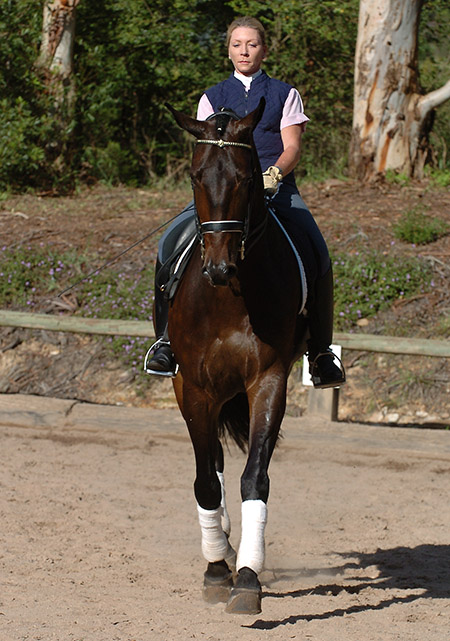 Straightness is the horseman’s eternal chore, no matter how educated the horse, he will always have that tendency to revert to his natural crookedness, he will always need the assistance of the rider to make him straight.
Straightness is the horseman’s eternal chore, no matter how educated the horse, he will always have that tendency to revert to his natural crookedness, he will always need the assistance of the rider to make him straight.
Jo Hinnemann is a rider as well as a trainer, he knows how much work it takes:
“Every horse naturally has an easier side. Just as every person is naturally right or left handed, so is every horse. We continue to emphasize that a rider’s job is to gymnasticize his horse, to attempt to alleviate this natural crookedness through correct work. A crooked horse can never move entirely in balance and always has an escape door through which the energy can’t optimally flow through from back to front. He can never correctly carry weight on his hindquarters. That’s why straightness is a very essential part of a horse’s training.”
(The Simplicity of Dressage, page 87)
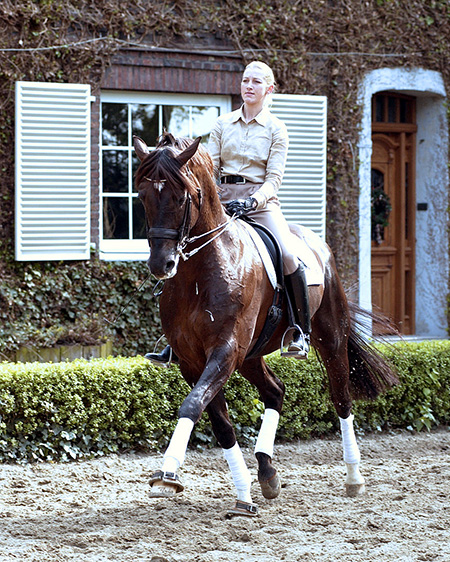
Marlies van Baalen, a pupil of Jo Hinnemann, and the stallion, Fidermark
As Clemens points out, riding your horse straight is not just riding straight lines, the horse has to be ‘straight’ on his bending lines as well.
“It is very important that the horse basically tracks up from behind, with the hind legs in the same direction as the front legs – that is straightness.”
“Basically you have to ride your horse straight, on circles or loops or whatever. The hind legs must exactly follow the direction of the front legs. On a straight line, or a bending line, on a circle, that never changes, the hind legs step in the same direction as the front legs. In Germany, the system says ride your horse forward and straighten it. If you ride your horse more forward, it will make it easier to get the horse straight.”
Ride your horse forward and keep him straight…
Gustav Steinbrecht, The Gymnasium of the Horse.
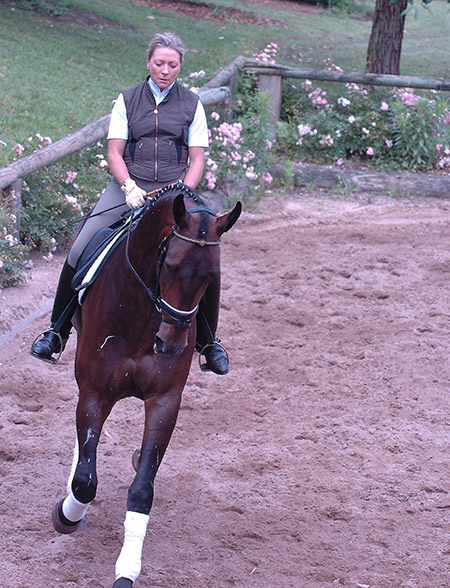
“To make the horse straight you think of putting the forehand in front of the quarters. If you are cantering to the left, and the horse swings his quarters in, you basically bring the shoulder fore, in line with the hindlegs, and that applies in all straightness. Adjust the front legs to hind legs – not the hind legs to the front legs.”
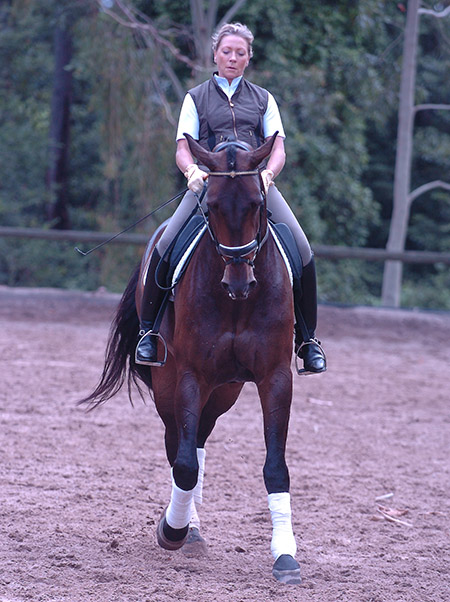
“We also use our lateral work, or bending, to help us straighten the horse. Basic leg yielding is a wonderful exercise to teach the horse to respond, to move off one leg, but all the lateral work is necessary so you can control your horse’s body. I think the leg yield is fantastic for half pass as it frees them up to cross over, it teaches them to go off the leg, and it is a very good movement to counter evasion. If you try to collect and the horse goes against your leg, immediately turn that into leg yielding to the other side. It is one of the most useful exercises I have found in training horses. A lot of people, they come down the centre line and they want to piaffe, and the horse takes off, then do leg yield to the opposite side from the one he wanted to take off to, maybe even with a few piaffe steps in it, and you can correct the horse. Instead of trying to stop the horse taking off, you put it into a movement, and the movement is leg yield.”
Right now Judy is demonstrating her control of Frontier’s body with some wonderful lateral work, the shoulder in flowing effortlessly into the half passes.
“When we ride shoulder in it is important to maintain the same forwardness, in the same trot. If the trot was a 7 or an 8 before, the shoulder in will be kept a 7 or an 8, because the pace remains the same in the shoulder in.”
“95% of riders when they come to ride shoulder in or half pass, suddenly go into a different gear, they don’t maintain the forwardness, or the big strides – and so score goes down. In the half pass, the rider really needs to be concentrating on trot, the main thing in the half pass strides is the beat, and to maintain the same quality of trot – that’s where most people fall down. In the half pass the shoulder always be leading, not the hindquarters, open the inside rein to allow the freedom of the inside shoulder. The shoulder must be a little in front.”
“Unless the horse is through, accepting the bridle and on the aids, he will never go straight. Every day you have to concentrate on making your horse straight, they are always finding ways to go crooked, no matter how long or how well you train them.”
“Absolute straightness in the whole length of the body is never natural to the horse at any pace beause of congenital asymmetry, but it is at the canter that the bend is more pronounced and the task of straightening him at this gait is especially difficult.”
General Decarpentry, Academic Equitation
“Counter canter is good to confirm and teach the straightness. Many riders try to ride the counter canter with a very big flexion to the leading leg, because they are not sure they can hold the horse in counter canter, but this means the horse is not really on the aids. The rider should be able to ride the counter canter, with just a little bend to the leading leg – the rider should even be able to flex the horse away from the leading leg and not lose the counter canter. The horse must be on the aids if it is to go straight. And straight if it is to go fully on the aids.”
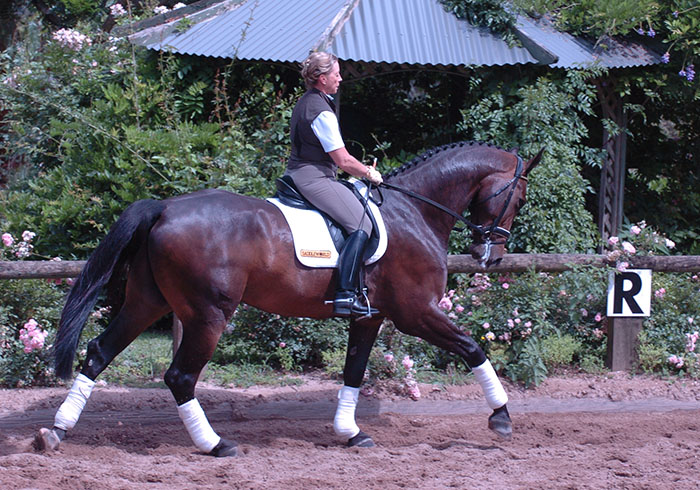
Although it is true that most horses are naturally inclined to move somewhat crookedly, crookedness can also be an acquired fault, caused by a rider who cannot feel the right moment for the use of legs or hands, slows the movement excessively, overshortens the horse or positions it wrongly in the lateral movements. ‘Pushing from behind and holding in front’ is often the advocated remedy for crookedness, and also often precisely the cause of crookedness. Once the horse has succeeded in disengaging a hind leg without the rider feeling and correcting the fault, the more the rider drives, the most he aggravates the situation. Unsympathetic hands are probably the major cause of crookedness.
Alfred Knopfhart, Fundamentals of Dressage
Next – the final principle of the German Scale – Collection
Breeding dressage horses? International Horse Breeders have a range of top European stallions available for the 2023 season, choose the right stallion for your mare: www.ihb.com.au
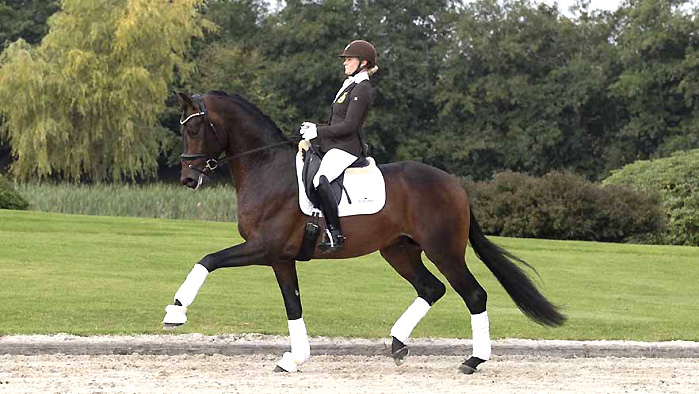
Dynamic Dream
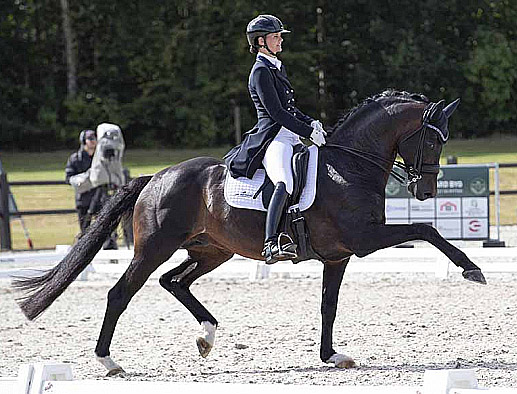
Franklin
